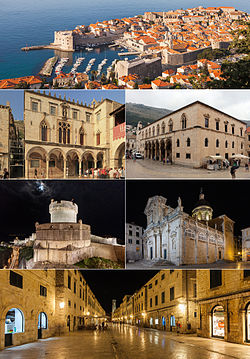Duchess of Ragusa
| Dubrovnik | |||
|---|---|---|---|
| City | |||
| City of Dubrovnik Grad Dubrovnik |
|||

Top: old city of Dubrovnik, Second left: Sponza Palace, Second right: Rector's Palace, Third left: city walls, Third right: Dubrovnik Cathedral, Bottom: Stradun, the city's main street
|
|||
|
|||
| Nickname(s): "Croatian Athens", "Pearl of the Adriatic", "Thesaurum mundi" | |||
| The location of Dubrovnik within Croatia | |||
| Coordinates: 42°38′25″N 18°06′30″E / 42.64028°N 18.10833°ECoordinates: 42°38′25″N 18°06′30″E / 42.64028°N 18.10833°E | |||
| Country |
|
||
| County | Dubrovnik-Neretva | ||
| Government | |||
| • Type | Mayor-Council | ||
| • Mayor | Nada Medović (Acting) | ||
| • City Council |
25 members
|
||
| Area | |||
| • City | 21.35 km2 (8.24 sq mi) | ||
| Elevation | 3 m (10 ft) | ||
| Population (2011) | |||
| • City | 42,615 | ||
| • Density | 2,000/km2 (5,200/sq mi) | ||
| • Urban | 28,434 | ||
| • Metro | 65,808 | ||
| Time zone | CET (UTC+1) | ||
| • Summer (DST) | CEST (UTC+2) | ||
| Postal code | 20000 | ||
| Area code(s) | 020 | ||
| Vehicle registration | DU | ||
| Website | www |
||
| Old City of Dubrovnik | |
|---|---|
|
Native name Croatian: Stari grad Dubrovnik |
|

The Old Harbour at Dubrovnik
|
|
| Location |
Dubrovnik-Neretva County, |
| Type | Cultural |
| Criteria | i, iii, iv |
| Designated | 1979 (3rd Session) |
| Reference no. | 95 |
| Extension | 1994 |
| Endangered | 1991–1998 |
| Official name: Stari grad Dubrovnik | |
Dubrovnik ([dǔbroːʋniːk]; historically Ragusa) is a Croatian city on the Adriatic Sea, in the region of Dalmatia. It is one of the most prominent tourist destinations in the Mediterranean Sea, a seaport and the centre of Dubrovnik-Neretva County. Its total population is 42,615 (census 2011). In 1979, the city of Dubrovnik joined the UNESCO list of World Heritage Sites.
The prosperity of the city was historically based on maritime trade; as the capital of the maritime Republic of Ragusa, it achieved a high level of development, particularly during the 15th and 16th centuries, as it became notable for its wealth and skilled diplomacy.
In 1991, after the break-up of Yugoslavia, Dubrovnik was besieged by the Serb and Montenegrin soldiers gathered in the Yugoslav People's Army (JNA) for seven months and suffered significant damage from shelling. After repair and restoration works in the 1990s and early 2000s, Dubrovnik re-emerged as one of the top tourist destinations in the Mediterranean.
The names Dubrovnik and Ragusa co-existed for several centuries. Ragusa, recorded in various forms since at least the 10th century, remained the official name of the Republic of Ragusa until 1808, and of the city within the Kingdom of Dalmatia until 1918, while Dubrovnik, first recorded in the late 12th century, was in widespread use by the late 16th or early 17th century.
...
Wikipedia



